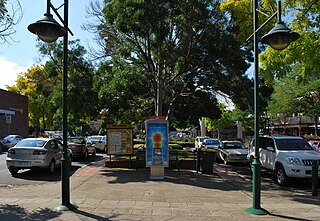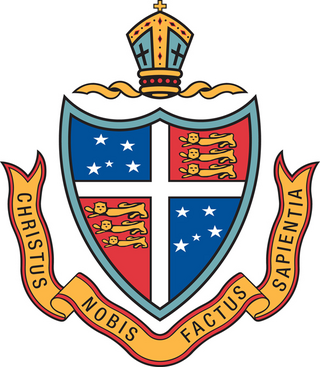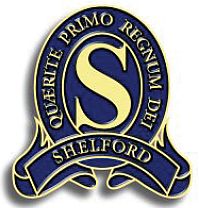
Geelong is a port city in Victoria, Australia, located at the eastern end of Corio Bay and the left bank of Barwon River, about 75 km (47 mi) southwest of Melbourne. With an estimated population of 282,809 in 2023, Geelong is the second largest city in the state of Victoria. It is the administrative centre for the City of Greater Geelong municipality, which is Port Phillip's only regional metropolitan area, and covers all the urban, rural and coastal reserves around the city including the entire Bellarine Peninsula and running from the plains of Lara in the north to the rolling hills of Waurn Ponds to the south, with Corio Bay to the east and the Barrabool Hills to the west.
This is a timeline of major events in the history of the city of Geelong, Australia.

Melbourne Grammar School is an Australian private Anglican day and boarding school. It comprises a co-educational preparatory school from Prep to Year 6 and a middle school and senior school for boys from Years 7 to 12. The three campuses are Grimwade House in Caulfield, Wadhurst and Senior School, both in the suburb of South Yarra.
Newtown is an inner western suburb of Geelong, Victoria, Australia. At the 2021 census, Newtown had a population of 10,445. It is a primarily residential area occupying one of the highest points of urban Geelong. It has always been a desirable place of residence and is the location of many of Geelong's oldest and most valuable properties.

Highton is a residential suburb of Geelong, Victoria, Australia. With views across Geelong, Corio Bay and the surrounding region, Highton is located along the banks of the Barwon River and across the rolling Barrabool Hills. The Barwon River straddles Highton to the north and east, while it is bordered by the hilly Ceres and Wandana Heights to the west, the former Kardinia Creek separates the suburb from Belmont to the south-east, and the Princes Highway and Pigdons Road to the south separate the suburb from Waurn Ponds.

Geelong Grammar School is a private Anglican co-educational boarding and day school. The school's main campus is located in Corio on the northern outskirts of Geelong, Victoria, Australia, overlooking Corio Bay and Limeburners Bay.

SCEGGS Darlinghurst is an independent Anglican single-sex primary and secondary day and boarding school for girls, located in Darlinghurst, an inner-city, eastern suburb of Sydney, New South Wales, Australia.
Clyde School was founded as a private girls' school in 1910 in Alma Road, St Kilda, Victoria, Australia by Isabel Henderson, a leading educationist of her day. It quickly gained a reputation for excellent academic results. The school was relocated to Macedon, near Hanging Rock in 1919.

Ballarat and Queen's Anglican Grammar School is a private, co-educational, Anglican, day and boarding school located in Wendouree (Ballarat), Victoria, Australia.

The Geelong College is an Australian independent and co-educational, Christian day and boarding school located in Newtown, an inner-western suburb of Geelong, Victoria.
Braemar College is an ecumenical co-curricular private school located on Mount Macedon in Woodend, Victoria, Australia. Initially the school's board consisted of representatives from the three local municipalities and the three local Christian denomination churches. The school's motto is Unum Corpus Multi Sumus.
Melbourne Girls GrammarSchool, is an independent, Anglican, day and boarding school for girls, located in South Yarra, an inner city suburb of Melbourne, Victoria, Australia.

Shelford Girls' Grammar is an independent Anglican day school for girls living in Caulfield, a suburb of Melbourne, Victoria, Australia.
The Headmasters' Conference of the Independent Schools of Australia (HCISA) was founded in 1931 and amalgamated in 1985 with the Association of Independent Headmistresses to form the Association of Heads of Independent Schools of Australia. It is the peak body representing the independent schools of Australia. It was modeled on the English Conference and was founded by four of the most influential Headmasters in Australia's history (Sir Francis Rolland CMG OBE, Sir James Darling, Leonard Robson CBE MC and the Rev Julian Bickersteth MC. A history of the Conference outlining its activities and influence was written by James Wilson Hogg MBE. The Journal of the Conference is held by the National Library of Australia.
Henry Thomas Langley was the Anglican Dean of Melbourne from 1942 to 1947.
Edward Prowse was an architect working in the Geelong region of Victoria, Australia in the late nineteenth century. He was responsible for many early Geelong buildings, including hotels, mansions and churches.
Joan Mitchell Montgomery was an Australian principal.
The Hon Charles Douglas Fisher, was the English-born Australian headmaster of Scotch College, Adelaide (1962–1969), Church of England Grammar School, Brisbane (1970–1973) and Geelong Grammar School (1974–1978).








